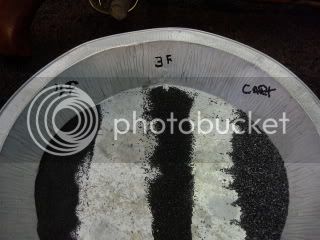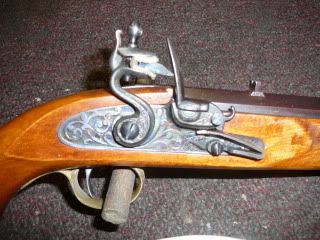- Joined
- Dec 25, 2011
- Messages
- 9,288
- Reaction score
- 4,452
While searching for the issue of Muzzle Blast with the inline flintlock I came across your article Larry in the 2009 march issue and had to comment on the very good job of testing you did. It was an outstanding and informative article.
I did a bit of testing on a much less rigorous and scientific scale than you did on vent and priming placement, on the moisture absorption of black powder. I used Goex cartridge, 3F goex and Kik 4 F lined out in a pan and subjected to my humidified bluing cabinet at nearly 100 percent humidity and about 88 degrees F on average.
At the end of each hour I pulled the open pie tin out and primed the pan of my flint pistol three times with each line of powder and observed the flash. I was not interested in timing them only reliability of ignition. I brushed out the pan each time before firing the nest one. All fired in every case. I did this each hour for five consecutive hours and noted the cartridge begin to give some hesitation at hours 4 and 5. The real surprise was the 4 f Kik which seemed to be impervious to the humidity which had reached the dew point with droplets covering the cabinet wall. It fired every time without hesitation that I could detect with my senses. As you pointed out in your article things would have to be really slow for us to sense notice.
This little practical test I ran starting with a new flint and alternating test granulation kept the playing field at least as level as one would encounter in real use. It totally debunked what I though I knew about finely grained black powder readily absorbing moisture.
I came to the conclusion that the fouling is probably the real culprit in miss and hang fires with flintlocks in wet weather as it readily absorbs moisture.

 My test pistol. MD
My test pistol. MD
I did a bit of testing on a much less rigorous and scientific scale than you did on vent and priming placement, on the moisture absorption of black powder. I used Goex cartridge, 3F goex and Kik 4 F lined out in a pan and subjected to my humidified bluing cabinet at nearly 100 percent humidity and about 88 degrees F on average.
At the end of each hour I pulled the open pie tin out and primed the pan of my flint pistol three times with each line of powder and observed the flash. I was not interested in timing them only reliability of ignition. I brushed out the pan each time before firing the nest one. All fired in every case. I did this each hour for five consecutive hours and noted the cartridge begin to give some hesitation at hours 4 and 5. The real surprise was the 4 f Kik which seemed to be impervious to the humidity which had reached the dew point with droplets covering the cabinet wall. It fired every time without hesitation that I could detect with my senses. As you pointed out in your article things would have to be really slow for us to sense notice.
This little practical test I ran starting with a new flint and alternating test granulation kept the playing field at least as level as one would encounter in real use. It totally debunked what I though I knew about finely grained black powder readily absorbing moisture.
I came to the conclusion that the fouling is probably the real culprit in miss and hang fires with flintlocks in wet weather as it readily absorbs moisture.






